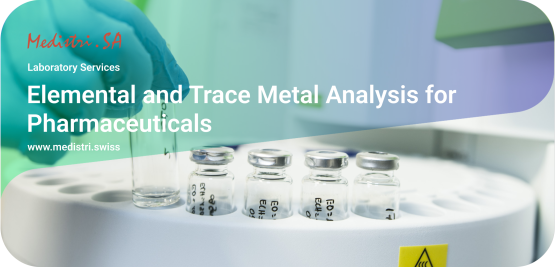(Download: Elemental and Trace Metal Analysis for Pharmaceuticals in PDF by Medistri)
Elemental Composition and impurity quantification testing services from GMP laboratories strengthen pharmaceutical development and GMP production — One of the support is Elemental and Trace Metal Analysis.
For pharmaceutical manufacturers, Elemental and Trace Metal Analysis is an important step towards development, quality control, and release.
Elemental and Trace Metal Analysis for Pharmaceuticals allow for a better understand of the elemental composition and purity of:
- The raw materials
- The APIs (active pharmaceutical ingredients)
- The Excipients
- The formulations
Through Elemental and Trace Metal Analysis, we’re able to detect potential unknown toxic compositions. Trace Metals can also have an influence on the stability of the formulations and impact catalysis degradation.
Medistri’s in-house GMP laboratory works with it customers to design pharmaceutical organic and inorganic elemental analysis.
Elemental and Trace Metal Analysis can be carried out in accordance to Pharmacopoeia USP 232 or Ph. Eur. 2.4.8 or USP <231> or to specific customer requirements.
The definition of heavy metals depend on their classification criteria. As a general framework, metals that have a density higher than 5 g/cm3 are categorised as heavy metals. They are also typically categorised as toxic elements.
One of the most common product analytical tests includes the toxic heavy metals such as As, Hg and Pb. In addition to measuring the starting materials it is essential to measure all finished products and in some cases intermediates, to demonstrate the compliancy with the various regulations.
🎯 To learn more about Medistri’s Elemental and Trace Metal Testing services for Pharmaceuticals, visit on our website at www.medistri.swiss or directly contact our team at contact@medistri.swiss.
- The Medistri Team
#Medistri
